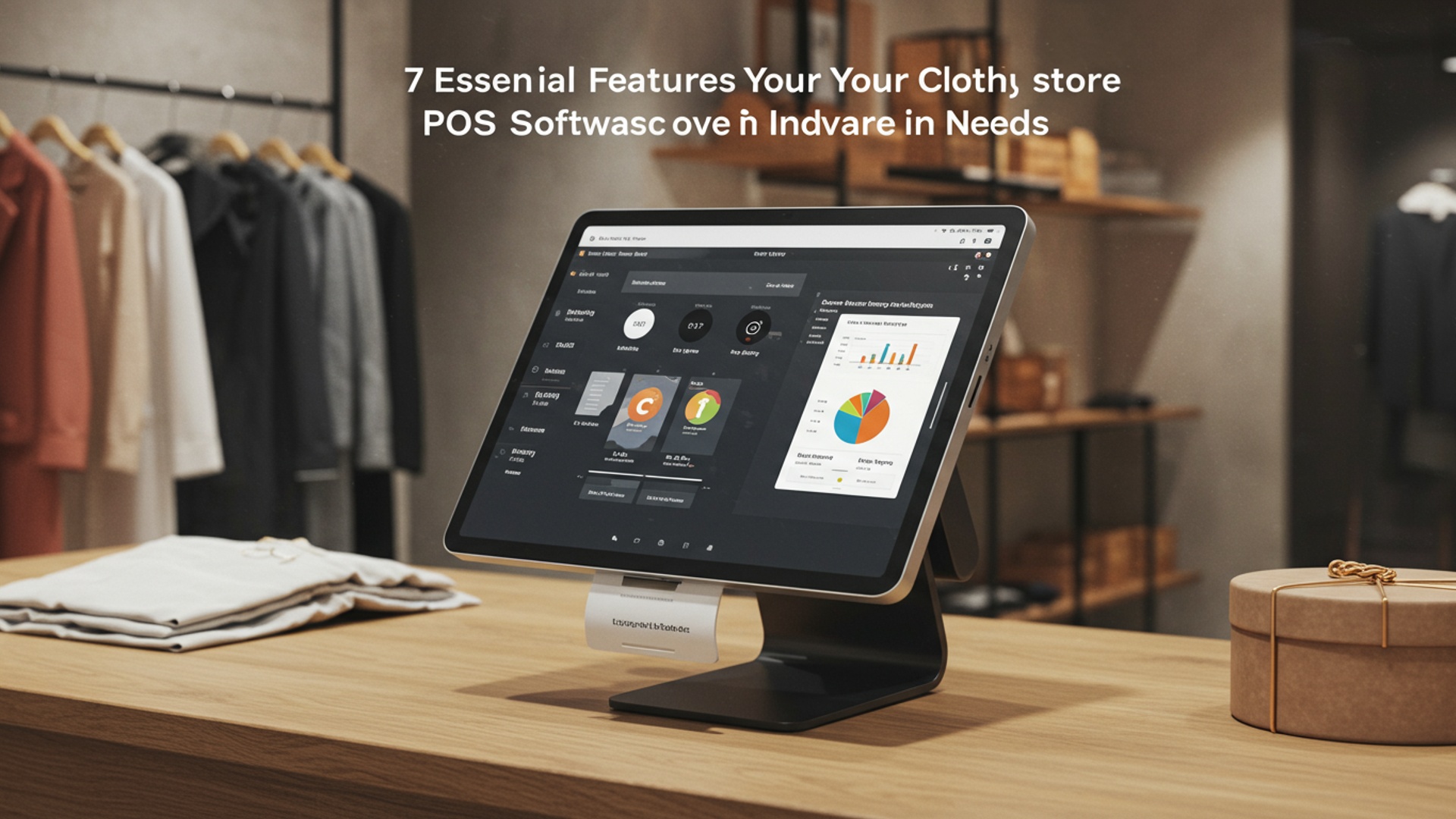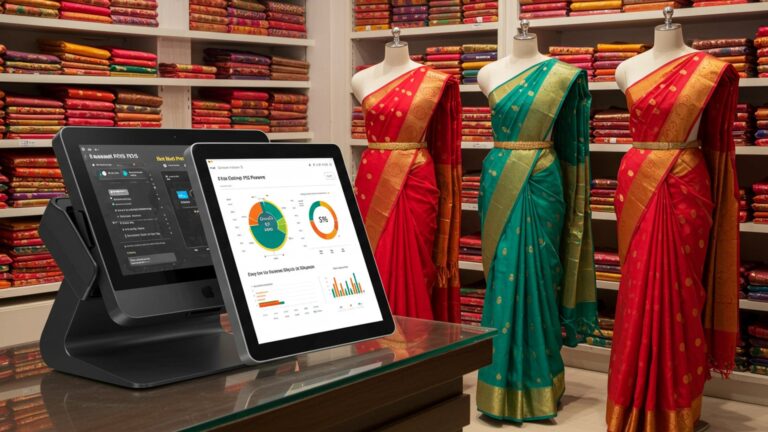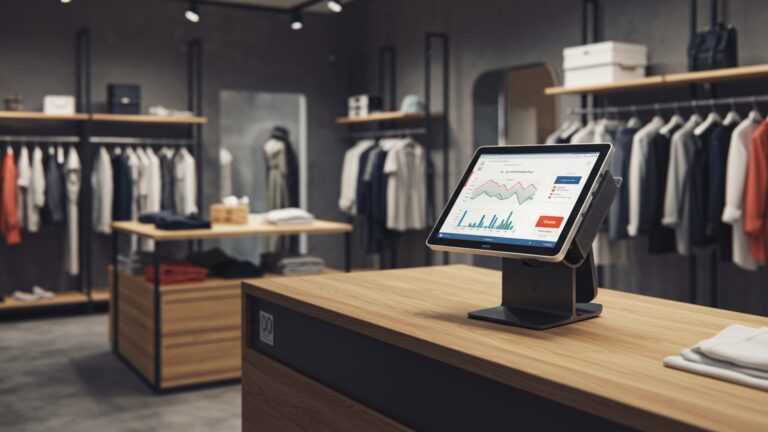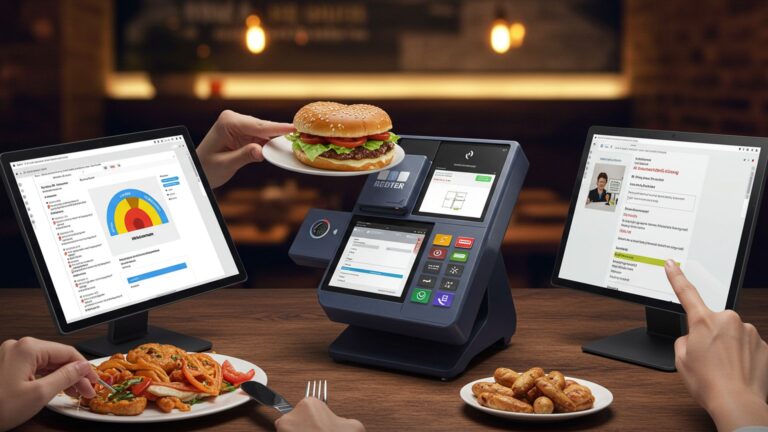7 Essential Features Your Clothing Store POS Software in India Needs
The dynamic Indian apparel market demands more than just transaction processing; it requires intelligent clothing store POS software India that actively drives efficiency. Amidst fierce competition and the rapid adoption of digital payment ecosystems like UPI, retailers must leverage systems capable of granular inventory control, personalized loyalty programs. seamless omnichannel integration. Such advanced solutions are crucial for optimizing seasonal sales, understanding complex customer purchase patterns. ensuring robust GST compliance, transforming operational challenges into strategic advantages for modern apparel businesses.

Streamlined Inventory Management with Variant Tracking
For any clothing store, effective inventory management is not just a feature; it’s the backbone of profitability. Unlike generic retail, clothing stores deal with a complex matrix of SKUs (Stock Keeping Units) that include variations in size, color, style. sometimes even material. A robust clothing store POS software India needs to handle this complexity effortlessly.
Inventory management within a POS system allows you to track every item in your store from the moment it arrives until it’s sold. For clothing, this means managing variants. Imagine you sell a t-shirt style. It doesn’t just have one SKU; it has multiple: “T-shirt Style A, Red, Small,” “T-shirt Style A, Red, Medium,” “T-shirt Style A, Blue, Small,” and so on. Each combination is a unique inventory item.
- Preventing Stockouts and Overstocking
- Accurate Stock Counts
- Optimized Merchandising
- Loss Prevention
Automated tracking helps you identify fast-moving items and slow movers. This is crucial for Indian fashion retail, where trends can shift rapidly. festivals drive specific demands. A POS that alerts you when stock levels are low for popular sizes or colors prevents lost sales.
Manual inventory counts are time-consuming and prone to errors. A POS system integrated with barcode scanning ensures real-time accuracy, reducing discrepancies and making stock audits faster.
By understanding which variants sell best, you can make informed decisions about future purchases and store layout. For instance, if you notice a particular color in a specific size consistently sells out, you can prioritize reordering that combination.
By tracking every item, the system helps identify discrepancies that might indicate theft or errors, improving overall accountability.
Consider “Fashionista Boutique” in Mumbai. Before implementing a specialized clothing store POS software India, their inventory was a constant headache. They often ran out of popular saree sizes during wedding season or had excess stock of out-of-season kurtis. After adopting a POS with variant tracking, they could instantly see stock levels for “Designer Saree, Silk, Red, Size L” across all their stores, enabling timely reorders and inter-store transfers, significantly boosting sales and reducing dead stock.
Efficient Sales & Transaction Processing with Diverse Payment Options
The checkout experience is the final, critical touchpoint for your customers. A slow, cumbersome process can negate all the effort put into attracting them. A top-tier clothing store POS software India must offer rapid, flexible. secure sales processing, catering specifically to the diverse payment landscape of the country.
This feature encompasses everything involved in completing a sale: scanning items, applying discounts, processing payments, handling returns/exchanges. issuing receipts. For clothing, it also includes specific functionalities like easy item lookup by size/color, gift card processing. layaway options.
- Speed and Customer Satisfaction
- Multiple Payment Gateways
- UPI (Unified Payments Interface)
- Mobile Wallets
- Debit/Credit Cards
- Buy Now, Pay Later (BNPL) options
- Seamless Returns and Exchanges
- Discount and Promotion Management
In a busy Indian market, customers expect quick service, especially during peak hours or festival sales. A fast POS minimizes queues and improves the overall shopping experience.
India is a leader in digital payments. Your POS must seamlessly integrate with various methods beyond cash and credit cards. This includes:
Essential for person-to-merchant payments.
Paytm, Google Pay, PhonePe, etc.
Via integrated card swipe machines (EDC terminals).
Increasingly popular for higher-value purchases.
Clothing retail has a higher return rate due to sizing issues or preferences. An efficient POS system makes this process smooth, allowing staff to quickly verify purchases and process exchanges or refunds, enhancing customer loyalty.
Easily apply percentage discounts, fixed amount discounts, BOGO (Buy One Get One) offers, or loyalty points redemption at the point of sale.
// Conceptual example of POS integrating with a payment gateway API
function processPayment(amount, paymentMethod, transactionDetails) { if (paymentMethod === 'UPI') { // Call UPI payment gateway API // Example: initiateUpiPayment(amount, transactionDetails. upiId); console. log("Processing UPI payment for " + amount); return { status: "success", transactionId: "UPI12345" }; } else if (paymentMethod === 'Card') { // Call Card terminal API // Example: sendToCardTerminal(amount); console. log("Processing Card payment for " + amount); return { status: "success", transactionId: "CARD67890" }; } else if (paymentMethod === 'Cash') { console. log("Cash payment received for " + amount); return { status: "success", transactionId: "CASH0001" }; } else { console. log("Unsupported payment method.") ; return { status: "failed", error: "Invalid payment method" }; }
} // Usage in a sales transaction
let totalBill = 2500;
let customerChoice = 'UPI';
let paymentResult = processPayment(totalBill, customerChoice, { upiId: 'customer@bank' });
if (paymentResult. status === 'success') { console. log("Transaction complete. ID: " + paymentResult. transactionId);
}
This code snippet illustrates how a POS might abstractly handle different payment methods by calling specific APIs or internal functions, making the checkout process versatile.
Robust Customer Relationship Management (CRM) for Loyalty
In the competitive Indian clothing market, customer loyalty is gold. A good clothing store POS software India doesn’t just process sales; it helps you build lasting relationships with your clientele. Integrated CRM capabilities turn anonymous shoppers into valued, repeat customers.
CRM features within a POS system allow you to capture customer data (name, contact details, purchase history, preferences) and use it to personalize their shopping experience and drive repeat business. It’s about understanding who your customers are and what they like.
- Personalized Marketing
- Loyalty Programs
- Enhanced Customer Service
- Birthday/Anniversary Discounts
Knowing a customer’s purchase history allows you to send targeted promotions. For instance, if a customer frequently buys traditional wear, you can inform them about new arrivals in that category or special offers during festivals like Diwali or Eid.
Easily implement points-based systems, tiered memberships (e. g. , silver, gold, platinum), or exclusive discounts for loyal shoppers. In India, where word-of-mouth is powerful, rewarding loyalty encourages repeat visits and referrals.
When a customer returns to your store, staff can quickly access their profile, see past purchases. offer more personalized recommendations or assistance with returns/exchanges, creating a seamless experience.
Automated triggers can send personalized wishes and special offers, making customers feel valued and encouraging them to shop.
“Ethnic Threads,” a boutique in Bangalore, struggled to retain customers. They knew their products were good. repeat business was low. After implementing a POS with CRM, they started capturing customer details and purchase patterns. They launched a loyalty program where customers earned points for every purchase, redeemable on future buys. They also began sending SMS alerts about new collections based on past purchases (e. g. , “New collection of Banarasi silks just arrived, perfect for you!”). Within six months, their repeat customer rate increased by 20%, showing the direct impact of personalized engagement.
Comprehensive Reporting & Analytics for Business Insights
Running a successful clothing store requires more than just selling clothes; it demands data-driven decisions. A sophisticated clothing store POS software India provides powerful reporting and analytics tools that transform raw sales data into actionable business intelligence.
This feature aggregates all transactional and inventory data and presents it in easy-to-interpret reports and dashboards. It provides insights into sales performance, inventory movement, customer behavior. employee productivity.
- Identify Best-Selling Products
- Track Sales Trends
- Monitor Employee Performance
- Optimize Inventory Turnover
- Profitability Analysis
grasp which styles, sizes, colors. brands are most popular. This is vital for purchasing decisions, especially with seasonal fashion trends and regional preferences in India.
examine daily, weekly, monthly, or yearly sales trends to predict future demand, plan promotions. staff accordingly during peak seasons (e. g. , wedding season, festive sales).
Track individual employee sales, average transaction value. productivity to identify top performers and areas for improvement in sales training.
Reports on inventory aging and turnover help identify slow-moving stock that might need discounting, freeing up capital for new, in-demand items.
comprehend gross margins per product, category, or even supplier, enabling smarter pricing strategies and vendor negotiations.
| Report Type | Description | Actionable Insight for Clothing Stores |
|---|---|---|
| Sales by Product/Variant | Shows total sales volume and revenue for each specific item (e. g. , “Blue Denim Jeans, Size 32”). | Identifies hot-selling items and variants, informing reorder decisions and marketing focus. |
| Sales by Category | Aggregates sales for broader categories (e. g. , “Men’s Ethnic Wear,” “Women’s Casual Tops”). | Helps comprehend overall category performance and allocation of display space. |
| Inventory Turnover | Measures how quickly inventory is sold and replaced over a period. | Highlights slow-moving stock that ties up capital, prompting clearance sales. |
| Customer Purchase History | Details individual customer purchases over time. | Enables personalized recommendations and targeted loyalty program offers. |
| Hourly Sales Report | Shows sales volume and revenue broken down by hour of the day. | Optimizes staff scheduling to match customer traffic patterns. |
These reports are indispensable for making informed business decisions, steering your clothing store towards greater efficiency and profitability in the Indian market.
Seamless Multi-Store Management and Centralization
As a clothing store grows from a single boutique to multiple outlets, managing operations across different locations can quickly become a logistical nightmare. This is where a robust clothing store POS software India with multi-store management capabilities becomes indispensable, offering a centralized view and control over your entire retail empire.
Multi-store management allows you to oversee and control operations for all your retail locations from a single, centralized dashboard. This includes inventory, sales, customer data. employee management across different branches.
- Centralized Inventory Visibility
- Consistent Pricing and Promotions
- Unified Customer Database
- Consolidated Reporting
- Streamlined Operations
Know the exact stock levels of every item (including variants like sizes and colors) at every store in real-time. This is critical for clothing retail, allowing you to fulfill online orders from any store, transfer stock between branches to meet local demand, or locate a specific item for a customer even if it’s not at their current store.
Ensure uniform pricing, discounts. promotional campaigns across all your outlets, maintaining brand consistency and avoiding customer confusion.
A customer who shops at your Delhi store can be recognized and offered loyalty benefits at your Bangalore store because their profile is accessible across the network. This enhances customer experience and loyalty.
Get a bird’s-eye view of your entire business performance, comparing sales, profitability. inventory turnover across different locations. This helps identify best-performing stores and areas needing improvement.
Manage product catalogs, employee roles. permissions centrally, reducing administrative overhead and ensuring operational efficiency across all branches.
“Vogue Attire,” a chain with five clothing stores across different Indian cities, initially struggled with decentralized systems. A customer looking for a specific designer lehenga in a particular size might be told it’s out of stock, even if it was available at another branch. By adopting a POS with multi-store management, their sales associates could instantly check stock across all locations. This not only improved customer satisfaction by facilitating inter-store transfers or direct shipping but also optimized inventory distribution, reducing instances of overstock in one store and stockouts in another.
This capability transforms a collection of individual stores into a cohesive, efficient retail network, crucial for scaling a clothing business in India.
Integrated Vendor Management & Purchasing
Managing suppliers and procurement is a significant aspect of running a clothing store, especially with the diverse range of fabrics, designs. seasonal collections. A comprehensive clothing store POS software India should extend its capabilities beyond sales to streamline your entire supply chain, starting with vendor management and purchasing.
This feature allows you to manage supplier details, generate and track purchase orders (POs), record incoming inventory. monitor vendor performance directly within your POS system. It connects your inventory needs with your procurement process.
- Efficient Purchase Order Creation
- Supplier Relationship Management
- Accurate Inventory Receiving
- Cost Control and Profitability
- Reduced Manual Work
Based on real-time inventory levels and sales data, the POS can help generate purchase orders for specific items (including variants like sizes and colors) that are running low. This automates a typically manual and error-prone process.
Keep a centralized database of all your vendors, including contact details, payment terms, historical purchase records. lead times. This is particularly useful in India where clothing stores might source from numerous local artisans, wholesalers. international brands.
When new stock arrives, scan items directly into your inventory using the purchase order. This ensures that what was ordered is what was received, immediately updates stock levels. helps identify discrepancies.
By tracking purchase costs, you can better assess your margins and negotiate better deals with suppliers. The system can alert you to price changes from vendors, impacting your overall profitability.
Automating PO generation and inventory receiving significantly reduces the administrative burden on your staff, allowing them to focus on sales and customer service.
When evaluating a clothing store POS software India, look for features that allow you to set reorder points for individual clothing variants. For example, if your “Women’s Kurta, Size M, Blue” drops below 5 pieces, the system should flag it for reorder and even suggest a PO to your preferred vendor for that item. This proactive approach ensures you never miss a sales opportunity due to stockouts.
Seamless Integration Capabilities with E-commerce and Accounting
In today’s interconnected retail landscape, a standalone POS system, no matter how powerful, is often not enough. For a modern clothing store in India, seamless integration with other vital business tools is paramount. A high-performing clothing store POS software India should act as a central hub, connecting your in-store operations with your online presence and back-office accounting.
Integration capabilities refer to the POS system’s ability to communicate and share data with other software applications, such as e-commerce platforms (e. g. , Shopify, WooCommerce), accounting software (e. g. , Tally, QuickBooks). marketing tools.
- Unified Inventory Management (Online & Offline)
- Streamlined Accounting
- Enhanced Customer Experience
- Operational Efficiency
- Data-Driven Growth
This is perhaps the most critical integration for clothing stores. When a customer buys a dress online, your in-store inventory should update instantly. vice-versa. This prevents overselling and ensures accurate stock levels across all sales channels. This creates an omnichannel experience for customers.
Eliminate manual data entry and reduce errors by automatically syncing sales data, returns. payment details from your POS to your accounting software. This simplifies tax filing (GST compliance is crucial in India) and financial reporting.
Integrations with CRM and marketing platforms allow you to leverage customer data from both online and offline purchases for targeted email campaigns, SMS promotions. personalized offers, improving customer engagement.
Automating data transfer between systems saves countless hours of manual reconciliation, allowing your team to focus on core retail activities rather than administrative tasks.
By consolidating data from all channels, you gain a holistic view of your business performance, helping you identify trends, optimize strategies. make more informed decisions for growth.
| Integration Type | Benefit for Clothing Stores | Common Platforms/Software |
|---|---|---|
| E-commerce Platform | Unified inventory, order management, customer data for omnichannel sales. Sell online and offline seamlessly. | Shopify, WooCommerce, Magento, OpenCart |
| Accounting Software | Automated financial reporting, ledger updates, GST compliance, reduced manual data entry. | Tally, QuickBooks, Zoho Books, Busy Accounting |
| CRM/Marketing Automation | Personalized campaigns, loyalty programs, email/SMS marketing based on purchase history. | Mailchimp, HubSpot, Salesforce (for larger stores) |
| Payment Gateways | Diverse payment options (UPI, wallets, cards) for seamless checkout. | Paytm, Razorpay, Instamojo, Stripe, CC Avenue |
Choosing a clothing store POS software India that offers robust, open APIs (Application Programming Interfaces) or pre-built integrations with popular Indian and global platforms ensures your business is future-proof and can adapt to evolving technology landscapes.
Conclusion
Ultimately, selecting the right POS for your Indian clothing store isn’t just about managing transactions; it’s about building a future-proof retail strategy. The features we’ve explored are not mere checkboxes but critical enablers for efficiency, customer satisfaction. growth. From my experience, a truly effective POS, like one handling real-time inventory across multiple stores or seamlessly integrating online returns with physical stock, is the bedrock of a thriving clothing business, especially with the festive season rushes common in India. Don’t just look for software that processes sales; seek a partner that simplifies complexities, from intricate sizing variations to managing customer loyalty programs. My personal tip is to prioritize a system that offers robust analytics, allowing you to quickly identify best-selling styles and optimize purchasing, a crucial insight in the fast-paced fashion industry. Embrace a POS that not only simplifies today’s tasks but empowers tomorrow’s growth, keeping pace with current trends like omnichannel retail and personalized customer engagement. Your investment in smart software is an investment in unparalleled customer experiences and sustained profitability. Choose wisely. watch your brand flourish.
More Articles
How to Implement POS Software for Seamless Sales and Inventory Management
Learn 8 Smart Inventory Control Strategies Using POS in India
How to Master Billing and POS Software for Efficient Retail Management
Learn 9 Practical Strategies to Streamline Billing Process and Boost Business Efficiency
FAQs
Why is precise inventory management so crucial for a clothing shop?
For a clothing store, inventory isn’t just about numbers; it’s about sizes, colors, styles. even fabrics. A robust POS helps you track every single variant, preventing stockouts of popular items and identifying slow-moving stock, which ultimately means fewer missed sales and better stock rotation.
How can a POS actually help me keep my customers coming back?
A good POS system comes with built-in CRM tools. It lets you capture customer data, track purchase history. run loyalty programs like points systems or special discounts. This personal touch makes customers feel valued and encourages repeat business, building a strong customer base.
What kind of insights can I really get from my POS data?
Beyond just sales figures, a powerful POS offers detailed reports. You can see which products are hot sellers, peak shopping times, employee performance. even customer demographics. These insights are gold for making smart decisions about merchandising, staffing. marketing strategies.
Do I really need my POS to handle returns and exchanges smoothly?
Absolutely! Returns and exchanges are a part of retail, especially in clothing. A streamlined process through your POS ensures quick transactions, updates inventory instantly. maintains accurate sales records. A hassle-free return experience can actually turn a potentially negative interaction into a positive one for the customer.
I’m thinking of opening another store. Can one POS system manage both?
Definitely! If you have multiple outlets or plan to expand, a centralized POS system is a game-changer. It allows you to manage inventory across all stores, view consolidated sales reports. even manage staff from a single dashboard. This integration saves time and provides a consistent experience across all your locations.
How does a POS make it easier to run sales or offer discounts?
Modern POS software makes setting up and executing promotions a breeze. You can easily configure various discount types – percentage off, buy-one-get-one, bundle deals – and schedule them to run automatically. This flexibility allows you to react quickly to market trends and drive sales without manual errors.
Why is GST compliance a big deal for my clothing store’s POS in India?
In India, staying GST compliant is non-negotiable. Your POS system must be capable of accurately calculating GST on all transactions, generating GST-ready invoices. providing detailed reports for filing. An incorrect system can lead to penalties and legal issues, so it’s a critical feature for any Indian clothing retailer.






